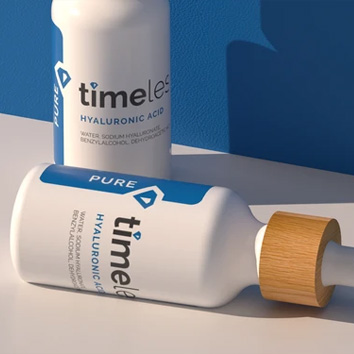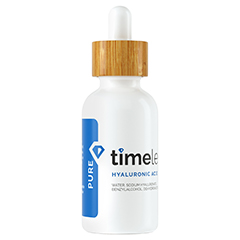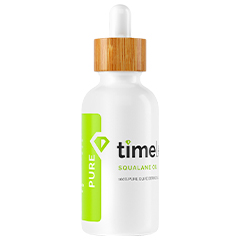How To Use Hyaluronic Acid In Your Routine?


2. What types of Skin can use the 100% Pure HA
3. Mixing Hyaluronic Acid with other active ingredients
4. Choose the skin care routine that fits you best!
Hyaluronic Acid has become a cult product for getting on your glow factor. Synonymous with hydration, Hyaluronic Acid runs the gauntlet from plumping and increasing volume, minimizing the appearance of wrinkles, and helping with skin elasticity! With so many benefits, many of us are wondering ‘how do I incorporate Hyaluronic Acid into my skincare routine?’ Are you ready for healthy, plump skin?
1. What is Hyaluronic Acid (HA)?
As a naturally occurring complex sugar in our body, especially for our skin, Hyaluronic Acid (HA) gradually decreases as we age. Topically, HA works as a humectant, renowned for its unique ability to attract and hold up to 1000 times its weight in water.Timeless Hyaluronic Acid 100% Pure uses a 1% concentration of sodium hyaluronate, which equates to 100% Hyaluronic Acid. Any higher concentration would actually gel up and dry out the skin, instead of delivering maximum permeability to help hydrate the face.
Prevent moisture loss by applying products well matched to your needs. Your skin health is crucial for overall life comfort, as it affects your outer and deeper cells in your body. Remember to drink a lot of water and eat well, taking care of yourself in and out.
Hyaluronic Acid and Dehydrated Skin
Since this ingredient attracts moisture, be careful how you use 100% Pure HA on dehydrated skin. In dry climates, especially in winter months, using it on dry skin can actually make it more thirsty, tight-feeling and crackled. When Hyaluronic Acid can’t draw moisture out of the air, it can actually start sucking moisture out of your skin.
This is why it’s so important to know how to use Hyaluronic Acid as a moisturizer, and how to incorporate it into your skincare routine.
Here are the top 3 tips for using Hyaluronic Acid in your skincare routine:
- If applying Pure Hyaluronic Acid on its own, always apply on slightly damp skin to help bind the moisture to your skin.
- Hyaluronic Acid assists in the delivery of active ingredients across the skin, so layer with your favorite serum for extra hydrating benefits.
- Seal in Hyaluronic Acid with a layer of facial oil, such as squalane oil, then finish with a moisturizer.
2. What types of Skin can use the 100% Pure HA?
Any skin type can use pure Hyaluronic Acid, it’s super light and watery, assisting in the delivery of active ingredients across the skin. Hyaluronic Acid 100% Pure is also the perfect clean ingredient for sensitive skin as well as oily or acne prone skin. Applying Hyaluronic Acid regularly can signal the body to produce less oil, helping to stop the vicious cycle of over-exfoliating and drying out the skin, which then triggers it to produce even more oil.How it works:
- nourishes
- moisturizes
Types of skin and cosmetic defects for which this product might be helpful:
- dry skin
- dehydrated skin
- mature skin

I have oily skin - is this product right for me? What about acne prone skin?
Yes!
HA is the ultimate savior for the skin, once you moisturize (even if you feel like your skin is too oily to put moisturizing in the spot) you help your skin get rid of dead skin cells to building up and causing oil production! If you have a breakout prone skin, you can still use this product. Maintaining skin hydration is crucial for any skin type!
sensitive skin - can hyalyronic acid cause irritation?
Yes and No
This ingredient is great for sensitive skin types. However, we must remember that ANY ingredient or product might cause allergenic effects, that is why it is so important to perform a test on a small area on your neck or hand and wait 24 hours to make sure it does not irritate our skin.
If you take any prescribed medications or suffer any skin condition requiring professional help, always remember to ask your dermatologist if it is safe to use any other skin care products aside from your treatment.
3. Mixing Hyaluronic Acid with other active ingredients
Can you use Vitamin C and Hyaluronic Acid together in your routine?Yes, these two make an excellent power duo! It helps to soothe and hydrate the skin barrier after the application of Vitamin C. HA + Vitamin C serum is a great combination of those two. It evens out the skin tone and helps the dull skin to retain moisture.
Types of skin and cosmetic defects for which this product might be helpful:
- skin with discoloration
- mature skin
- dry skin
- combination skin
You can also combine Hyaluronic Acid Pure with a facial oil or moisturizer to help seal and fortify the skin barrier:.
- Squalane Oil, known as "The Protector". Squalane soothes irritation and brings relief to the dry and cracked skin. Recommended for all skin types.
- Argan Oil, known as "The Nourisher", rich in Vitamin E, unsaturated fatty acids (oleic and linoleic) and natural antioxidants. It tones your skin, as Argan Oil has amazing healing and repairing properties for skin, hair, and nails. Mature, dry and skin with the signs of aging will find it most beneficial.
Can you use Retinol and Hyaluronic Acid together?
Yes, HA compliments Retinols (Vitamin A), hydrating and protecting the skin against the harsher effects of Vitamin A which can cause redness, flaking and irritation.
What about all three – can I use Retinol, Vitamin C and Hyaluronic Acid together?
As a rule, Retinol and Vitamin C don’t mix well together. Retinol works at a higher pH level compared to Vitamin C, which works more effectively at a lower acidic level.
HA can be safely combined with either ingredient, preferably Hyaluronic Acid with Retinol at night (since Vitamin A is prone to photosensitivity) and for daytime use, Hyaluronic Acid with Vitamin C is a great combination, helping to brighten, nourish and protect!

4. Choose the skin care routine that fits you best!
Try This Routine! Refresh skin moisture levelsWhen it comes to getting the most out of your Hyaluronic Acid, here is a suggested order for applying products:
- Step 1 - Gentle cleanser
- Step 2 - Serum(s)
- Step 3 - Hyaluronic Acid Pure - apply directly to the skin or mix with your moisturizer in Step 4
- Step 4 - Squalane Oil - use as a facial primer to seal in moisture and protect the skin from the environment
- Step 5 - Moisturizer and eye cream
- Step 6 - SPF
As Esthetician and Timeless Skin Care Education Specialist, Shelly Leggins says, “Just as water is to a sponge, applying HA serum topically helps plump up the skin. Hydrated skin is beautiful skin!”
Let's work together for healthy skin!
DISCLAIMER: The information on our blogs has been compiled from published sources and the experience of the Timeless Skin Care team. The blogs are not intended to diagnose or treat a medical condition or to address every skin type or condition. While reasonable effort is made to publish reliable and up to date information, Timeless Skin Care cannot predict how a skin care regimen will affect every individual user. Timeless does not guarantee any specific outcomes or the accuracy of all information presented and accepts no liability in respect of any omission or error. If you are uncertain about possible sensitivity when using Timeless Skin Care products, please do a patch test before use. If you have any skin concerns, please talk to your physician or consult a dermatologist.



